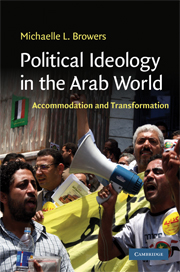Book contents
- Frontmatter
- Contents
- Acknowledgments
- Glossary
- Introduction: Ideological thought and practice in the Arab region
- 1 Retreat from secularism in Arab nationalist and socialist thought
- 2 A more inclusive Islamism? The wasatiyya trend
- 3 Framing a cross-ideological alliance
- 4 The Egyptian Movement for Change: Intellectual antecedents and generational conflicts
- 5 Yemen's Joint Meeting Parties: Origins and architects
- Conclusion: Ideological rapprochement, accommodation, transformation – and their limits
- Bibliography
- Index
- Cambridge Middle East Studies
5 - Yemen's Joint Meeting Parties: Origins and architects
Published online by Cambridge University Press: 22 January 2010
- Frontmatter
- Contents
- Acknowledgments
- Glossary
- Introduction: Ideological thought and practice in the Arab region
- 1 Retreat from secularism in Arab nationalist and socialist thought
- 2 A more inclusive Islamism? The wasatiyya trend
- 3 Framing a cross-ideological alliance
- 4 The Egyptian Movement for Change: Intellectual antecedents and generational conflicts
- 5 Yemen's Joint Meeting Parties: Origins and architects
- Conclusion: Ideological rapprochement, accommodation, transformation – and their limits
- Bibliography
- Index
- Cambridge Middle East Studies
Summary
In November 2005, the secretary-generals of Yemen's largest Islamist party, the Reform Gathering (al-tajammu 'al-yamani lil-islah, hereafter, Islah); the Socialist Party (YSP) that ruled the south prior to unification; the Popular Nasirist Unity Organization; and a small party consisting largely of liberal Zaydi intellectuals, the Union of Popular Forces (UPF), announced the publication of “The Program of the Joint Meeting for Political and National Reform” in a joint press conference. The conservative Zaydi Party, al-Haq, also signed the document. In July 2006, these same five parties upped the ante of their alliance by nominating Faysal bin Shamlan, a former oil minister and independent member of parliament, to oppose Yemeni president ‘Ali ‘Abdullah Salih's bid for re-election. The composition of the oppositional alliance that has come to be known as the Joint Meeting Parties (ahzab al-liqa al-mushtarak [JMP]) is particularly surprising when one considers that since unification in 1990 the ruling General People's Conference (almu' tamar al-sha'bi al-'am [GPC]) and President Salih have sought to pit the two main parties to the agreement – the YSP and Islah – against each other through a process of alliance with – or bolstering of – one at the expense of the other. As recently as 1994, these two parties were literally killing each other in Yemen's War of Succession. The JMP joins groups committed to secularism with groups committed to implementing Islamic law (shari'a), Zaydi Shi'is with Shafi'i Sunnis, and Islamists with socialists and Arab nationalists. How did such ideologically opposed groupings come together to stand under a common platform and behind a single presidential candidate? What is the significance of this alliance for Yemeni politics?
- Type
- Chapter
- Information
- Political Ideology in the Arab WorldAccommodation and Transformation, pp. 138 - 174Publisher: Cambridge University PressPrint publication year: 2009



